Alban Bassuet - alban.bassuet@arup.com
Arup Acoustics
155 Avenue of the Americas
New York, NY 10013 USA
Popular version of paper 5aAA6
Presented Friday morning, May 28, 2004
147th ASA Meeting, New York, NY
This paper describes the acoustic research undertaken by Arup Acoustics to
study the acoustics of rooms that played an important role in the development
of classical music. This research is the first phase of a music center project
that includes a Recital Hall (800-1000 seats), a "Jewel Box venue (150
seats), a "Ball Court" setting (200 seats) and an Opera House (600-800
seats) to be designed by Arup Acoustics in conjunction with Stubbins Architects.
The project, called Constellation Center, will soon be built on a site that
has been acquired in Cambridge, MA, near the Massachusetts Institute of Technology
(MIT). These four rooms will be used for a wide range of music events, including
classical and early music, opera, jazz, folk, blues, and world music, along
with classic film, dance, theatre, and digital media.
The goals of the client, Glenn A. KnicKrehm, President of the Constellation
Center, are strongly drawn to performance spaces for which many of the world's
masterpieces were composed; favorite spaces used by such luminaries as Mozart,
Beethoven, Haydn, Stravinsky, Schoenberg, Bach, and Berlioz. The importance
of these spaces was reinforced through discussions with eminent performers.
Mr. KnicKrehm wants to create an experience that would result in "physical
manifestations" (such as heart pounding, raised neck hairs, goose bumps,
tears of joy). He had experienced this in certain historical venues in Europe,
but was not able to experience the same empathy in modern halls in the United
States.
In order to carry out these objectives we needed to understand the acoustics
of the early rooms. The problem was that research of smaller historic rooms
has never been conducted to any great extent, as the majority of the research
has been associated with designing larger concert halls.
At the beginning of the project, an architectural research study led us to identify
approximately 200 historical rooms in Europe, (notably in Paris, Vienna, Amsterdam
and Rome), that played a key role in the development of music. Eventually, over
600 rooms were identified and visited by the project team members. Of these
rooms, seven room types surfaced across different cultures and music genres.
These can be roughly summarized as:
- the Great Hall of the palaces, similar to the enclosed chancels of large churches,
- the first Anteroom in various Renaissance and Baroque palaces,
- the size of the Medieval Tennis Court, a size later often used for opera,
theater and music performance,
- the Bach-style Organ Church,
- the Basilica - various sizes from small to large
- the Small Household Music, and
- the Baroque Opera House.
The following pictures show a typical example of each type of room.
 |
 |
| Waalseekerk, Dutch Organ Church | HaydnSaal, Great Hall |
 |
 |
| Esterhaza Music Room, Jewel Box | EmpireSaal, Ball Court |
 |
 |
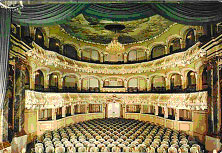 |
| Santa Cecilia, Roman Basilica | Gonfalone Oratorio | Schwetzingen, Baroque Opera House |
Of these 600 rooms, 65 rooms were selected for testing. The map below shows
the main destinations of our study. The first measurement trip lasted two weeks
and took place in June 2001, where rooms in Vienna, Fertõd, Eisenstadt,
and Salzburg were tested. The second measurement trip lasted two weeks in September
2001, where venues in Rome, Amsterdam, and London were measured. The last trip
took place in January 2003 and focused on Baroque Opera Houses in France, Germany,
and Sweden.
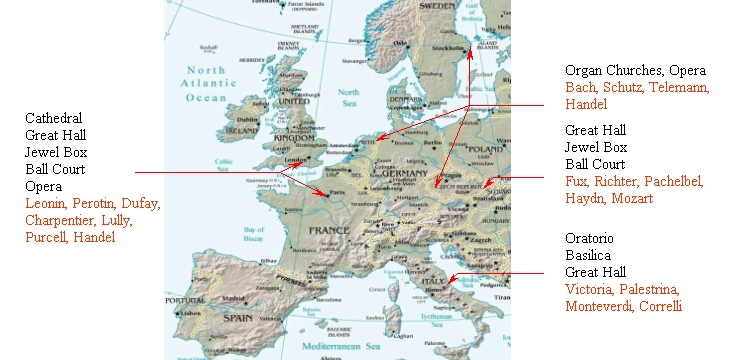 |
|
Emerging room types during Early Music period and
main
destination cities for the acoustic measurements |
The acoustic study was planned with three specific aims:
1- To capture the acoustic responses of the room such that they could be broken down into information in 3 dimensions
2- To graphically represent not only as 2D images but also real time graphics the acoustic response of each space
3- To be able to ambisonically reproduce the sounds of each of the spaces and to conduct listening tests and comparisons in the Arup SoundLab in order to use this information constructively to design the new performance spaces (A-B comparisons in sound lab).
Measurement Technique
In order to study the fine acoustic details of these rooms, the measurements
were carried out over a large audible frequency range and with the use of microphones
able to record the room reflections in three dimensions. The test signal were
captured with 5 microphones:
- B-format Soundfield microphoneThe sound source was composed of a dodecahedron Bruel & Kjaer 4296 and a sub TANNOY PS10. The test signals were recorded onto two 4-tracks digital hard-drive recorders, DEVA. Two people conducted the measurements, with a maximum of three hours per room. The following pictures describe the measurement equipment which was used for the tests.
- Dummy head (Neuman KU 100)
- Omni Bruel & Kjaer
- Figure of 8 Schoeps
 |
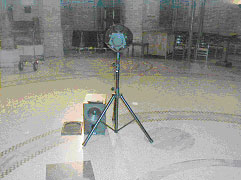 |
| Alban Bassuet and Neill Woodger | Test source: dodecahedron and subwoofer carrying the DEVA digital recorder |
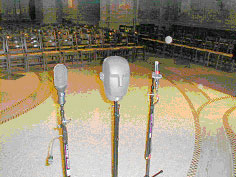 |
 |
| 3D- B format, Dummy Head, omni, and figure of eight microphones |
Omni and figure of eight microphones |
During the tests, music was recorded either using the loudspeaker or real musicians.
For the Opera measurement trip, a soprano followed us during the measurements.
Her performances were recorded in every hall and played back in the sound lab.
For the other rooms, music simulation was recreated by convolving anechoic music
materials with the impulse responses of each room. Both modern and early music
instruments, 36 in all, were recorded in anechoic chamber for that purpose (organ,
flute, lute, harpsichord, drums, violin trio, etc).
Example of Results
The impulse responses were deduced using sweep signals. The sweeps were deconvolved
using Aurora plug-in for CoolEdit. The acoustic parameters were calculated using
Matlab routines by Alban Bassuet. The computation of standard acoustic parameters
provided useful information, but they did not show the acoustic subtitles which
make these rooms unique. New 3D parameters were created by studying the 3D impulse
responses given by the B-format microphone to show the fine details of the sound
reflections. The analysis includes new 3D sound representations and the calculations
of new parameters such as spatial balance. This parameter was created in order
to show the balance between the lower lateral and upper lateral sound reflections,
in order to distinguish acoustic aesthetics.
 |
| Standard acoustic parameters |
 |
| Narrow frequency band representation of energy decay |
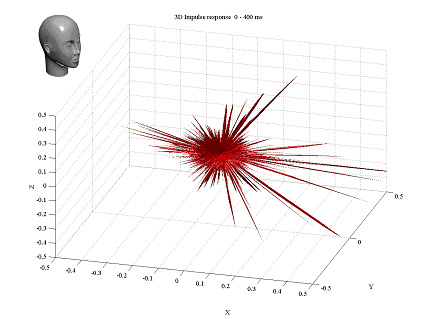 |
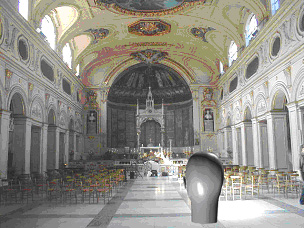 |
| 3D impulse response showing reflection incidences at listener position in the center, looking towards positive X. Measurement from Santa Cecilia Basilica, Rome |
Listening Study
Detailed results of the study will be presented in future articles. A brief
discussion about the preliminary results is provided below.
The listening study, consisting of comparing room responses side-by-side, revealed
very distinct differences between the acoustic signatures. Firstly, the most
obvious observation was that these rooms are loud and reverberant so their acoustics
participate greatly in the musical experience, in a sense that we are not used
to anymore. They convey an enhanced sensation of tonal beauty, sound envelopment,
and combined reverberance and music clarity. Listening to music in these rooms
is a very emotional and engaging experience. Secondly, as expected, it appeared
that the room types were optimum for the reproduction of music that they were
originally used for; Organ churches were optimum for 17th century German organ
repertoire, Great Halls were optimum for early symphony orchestra compositions,
Roman Basilica were optimum for plainchant, etc.
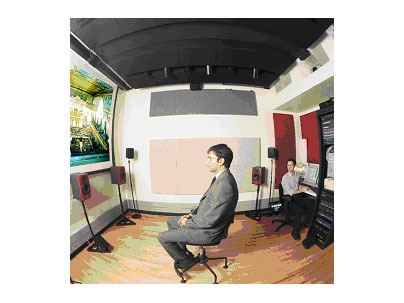 |
 |
|
Auralization study in ArupSoundlab facility
|
|
The acoustic coefficients showed that the room tonal qualities were influenced
by the variation of reverberation with frequency, room resonances and by the
acoustic properties of the surface materials enhancing the sound of the instrument
(timbre). As examples, the Organ churches have a gap of reverberation in the
mid bass that complements the sound of the 17th century German organ sound and
allows fast parallel melodies and clear music counterpoints. The Shoebox rooms
create strong modal resonances that support the weak string instrument in the
bass register. In the Baroque opera houses, the thin wooden walls absorb the
mid bass and the thick stone structural walls enhance the lower bass of the
music.
Further in the study, it was shown that the reflection sequences (reflection
timing) had an important role in the complementarity between the music and the
acoustics. As an example, Roman basilicas tend to create late sound reflections
(80 - 150 ms) which perfectly suits Roman plainchant thereby creating imaginary
sound sources enhancing the feeling of sound envelopment. However, during the
listening study, these reflections disrupted the perception of localization
when orchestral music was simulated in these rooms. Although late reflections
also appear in the Great Hall room type, the reflection patterns are different.
The rectangular Shoebox shapes and sizes of the Great Halls have similar reflection
sequences, and identical reflection clusters emerge. As discussed further in
the analysis, these particular reflections are responsible for combining the
perception of reverberance, clarity and envelopment.
As demonstrated by the acoustic parameters (such as IACC and LEV) and the listening
study, one of the acoustical aspects that these rooms achieve at a perfection
level resides in the enhancement of perception of sound envelopment. The Great
Hall dimensions increase the sensation of orchestra dimensions due to the optimum
incident reflected sound from the side walls. They also convey a deep enveloping
sound from the middle to the rear with the benefit of rear corner reflections.
This phenomenon can also be observed in both Jewel Box and Ball Court types.
The role of the "enveloping" quality of these rooms is even more obvious
in the German Baroque opera houses. These rooms have short reverberation time,
and their musicality is conveyed by the quick reflections following the direct
sound from the stage. Some of these rooms were sculptured from the inside, and
surface curvature was purposely used to enhance reflections. In that sense,
Schwetzingen Rokokotheater in Germany built in 1752, represents the golden age
of opera house design that found its ultimate realization (from an audience
perspective). In more technical terms, Schwetzingen provides a balance between
lower lateral and upper lateral envelopment at most seats, as the data analysis
exposed in detail.
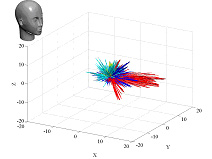 |
 |
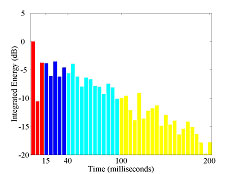 |
| 3D impulse response in Schwetzingen Rokokotheater (scale
in dB) shows 3D energy of reflections, listener looking toward positive
X |
Projection on the X-Y plan. Lateral reflections enhancing "spaciousness" are clearly shown | Integrated energy decay, showing reflection timing |
Perspectives for Modern Designs
The most important conclusion that this research study brings to light is the
lost knowledge of the past to design music rooms, which considered strongly
the room shape as a fundamental aspect of the acoustics. A fundamental change
occurred during the early 20th century which required larger orchestras and
when music became a business industry. Also, at the beginning of the 19th century,
with the invention of the reverberation time coefficient, concert hall design
tended to focus on achieving optimum reverberation time to the detriment of
room shape and size. The knowledge of the past to design smaller engaging music
spaces was lost.
This paper is an invitation to rethink modern design and to consider more strongly
the importance of room size and shape which can now be studied with computer
models and auralization techniques. Spaciousness perception and room characteristics
can be optimized using these techniques.
Appreciation of music is a multi-dimensional phenomenon and these rooms were built in parallel to the music and habitat evolution. Therefore, architecture and acoustics were intrinsically linked. From an architectural point of view, the trend of these rooms is that architecture tends to reinforce the feeling of "room ness". From an acoustic point of view, this acoustic study shows that the acoustic achievement of these rooms is mostly based on their size that is in scale with human perception characteristics. Our hope is to transpose the knowledge of past to conceiving music rooms into modern designs.